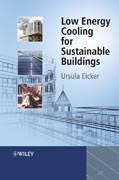
The book presents a broad overview on low energy cooling technologies for energy efficient buildings. The energy demand of residential and office buildingsis analysed first, complete with experimental results on fasçades and summer performances. Solutions for buildings whose cooling energy demand are low are considered in the first half of the book. These include the following: passivecooling strategies, such as passive night ventilations (explored with a simulation of passive cooling potential); geothermal heat exchangers for cooling, accessed in chapter four; and active thermal cooling technologies (including absorption and desiccant cooling), with monitoring results detailed in chapter five. These solutions are discussed as possible replacements for electrically powered compression chillers. The next chapter is larger, detailing solutions for cooling systems that are required for high cooling loads. Chapter six covers sustainable building operation using simulation; of solar cooling systems, online simulation of buildings and renewable energy plants. The potential for rational energy use through optimization of operational performance is shown.
- ISBN: 978-0-470-69744-3
- Editorial: John Wiley & Sons
- Encuadernacion: Cartoné
- Páginas: 276
- Fecha Publicación: 27/03/2009
- Nº Volúmenes: 1
- Idioma: Inglés
